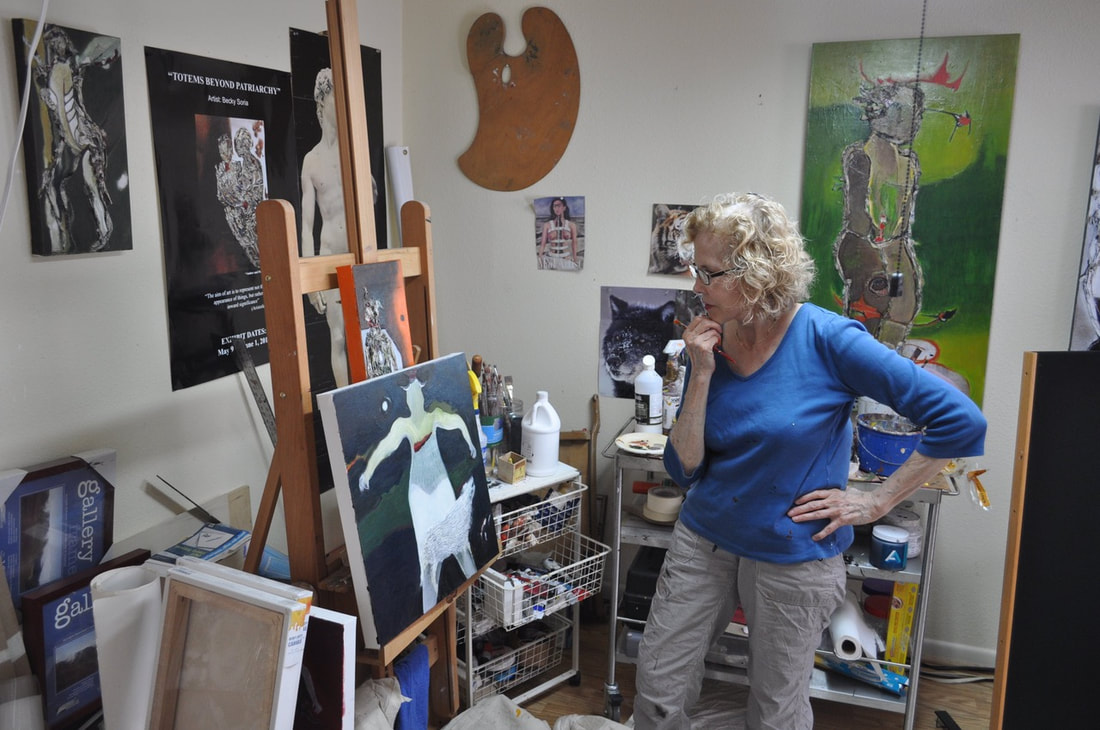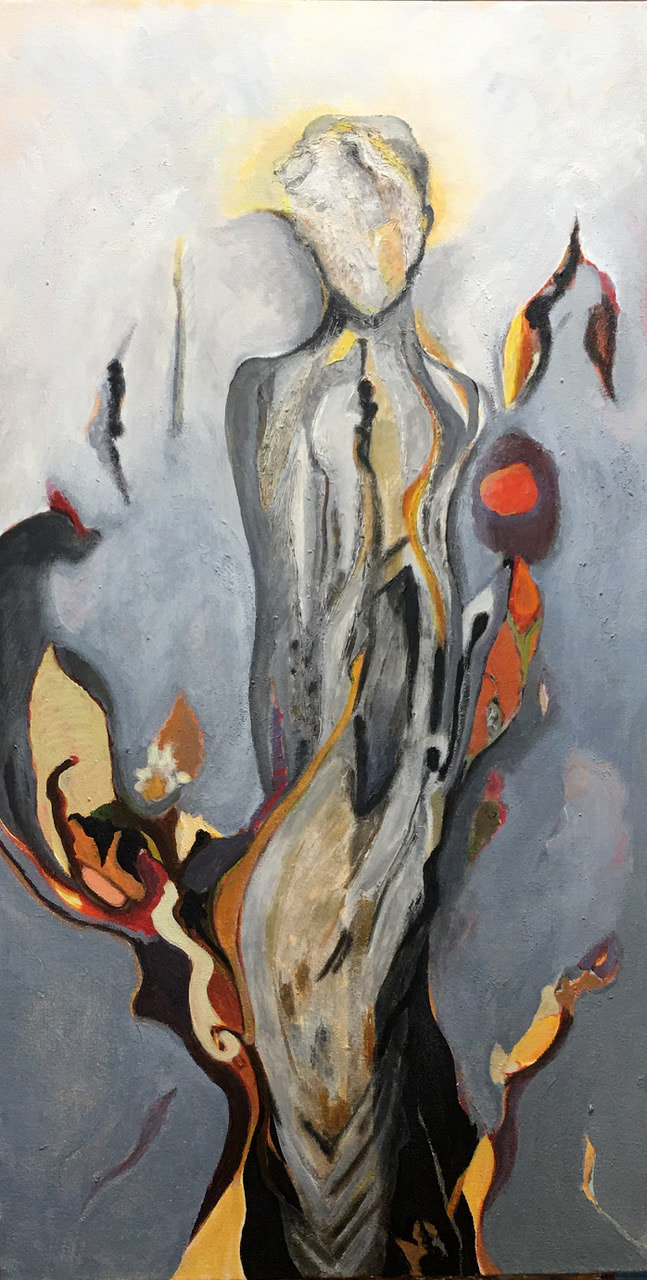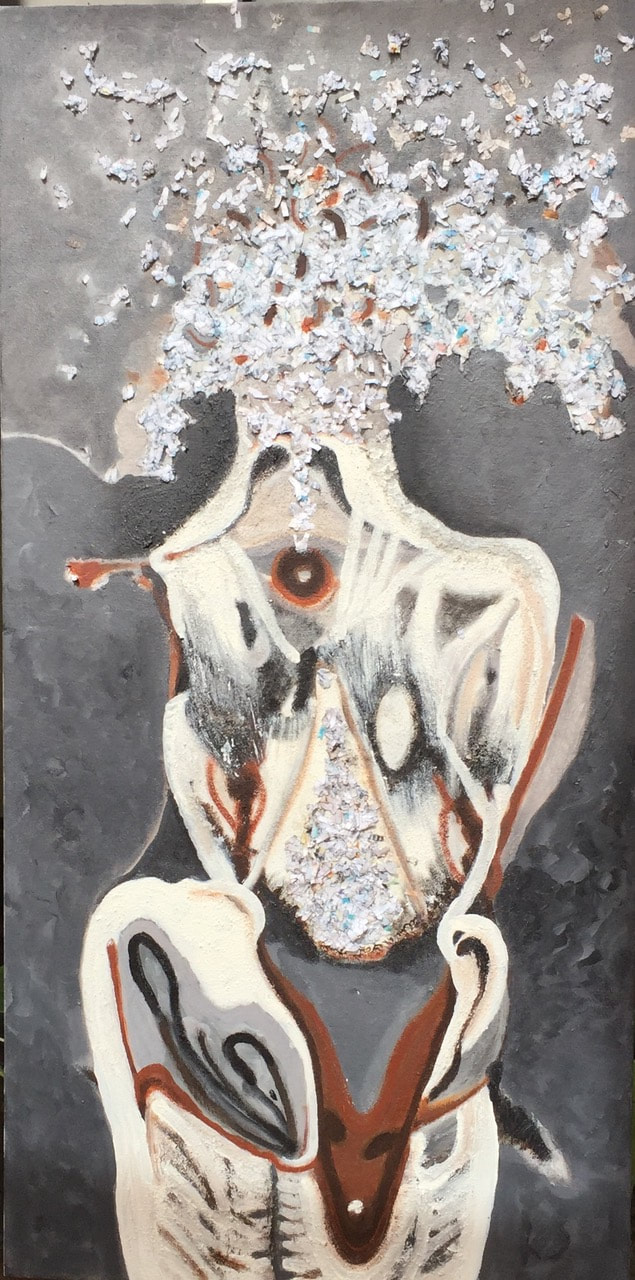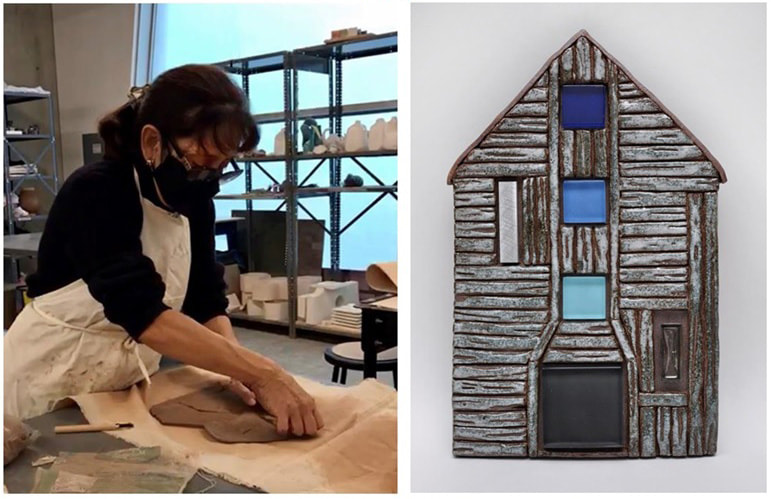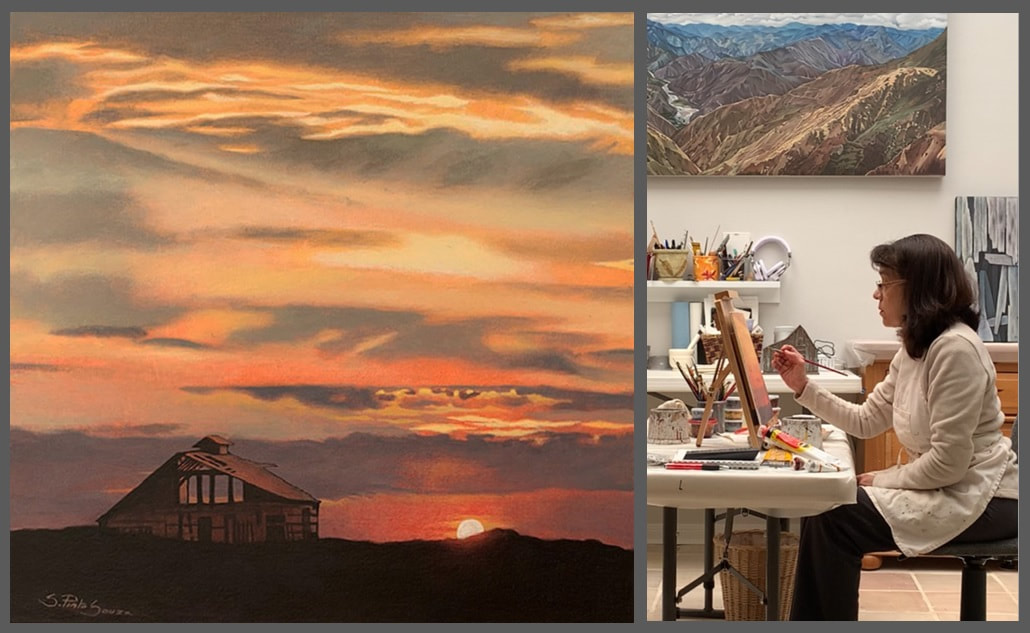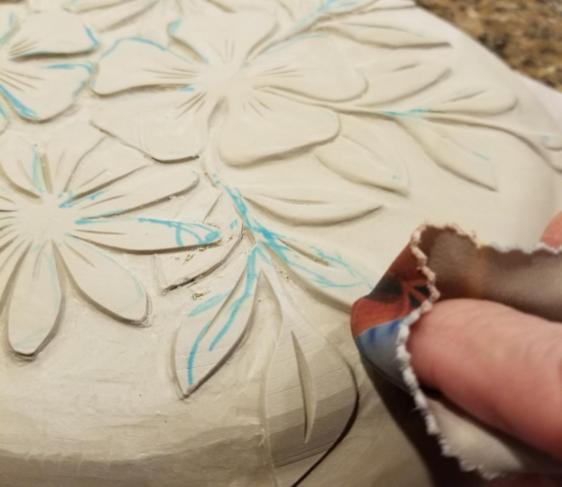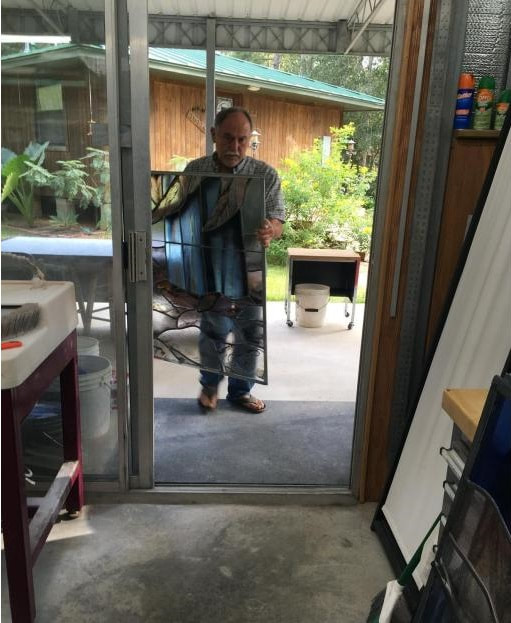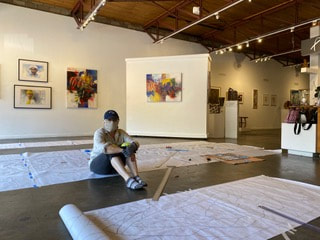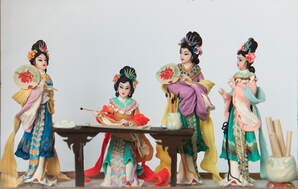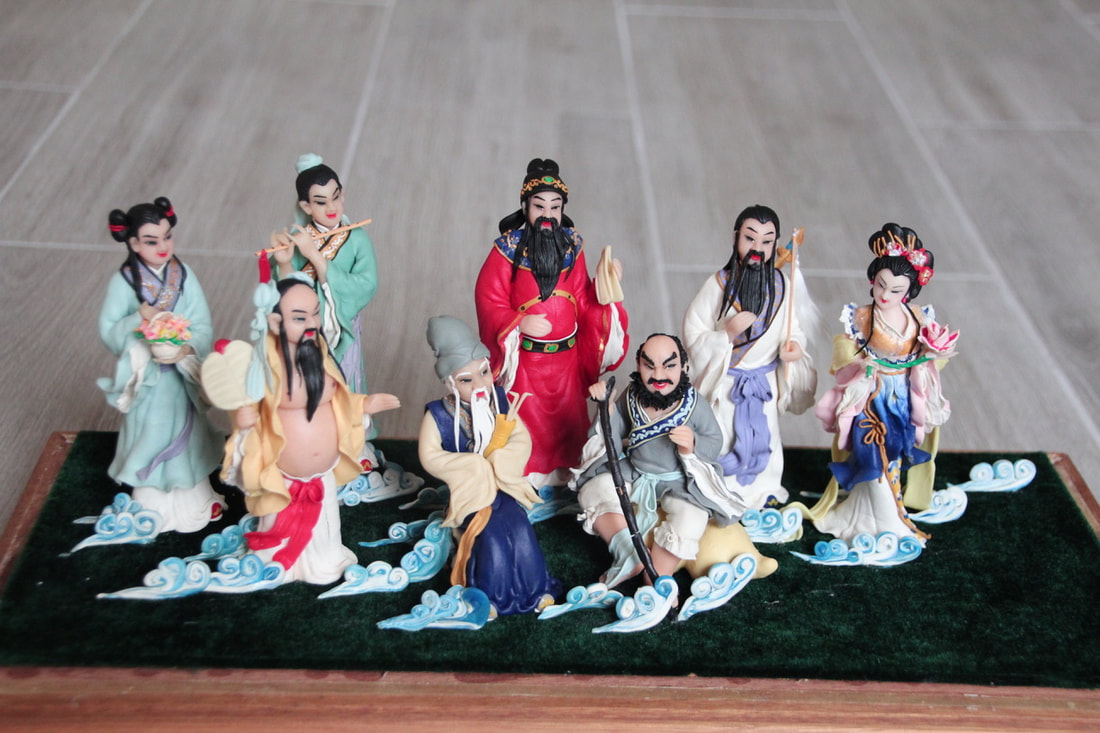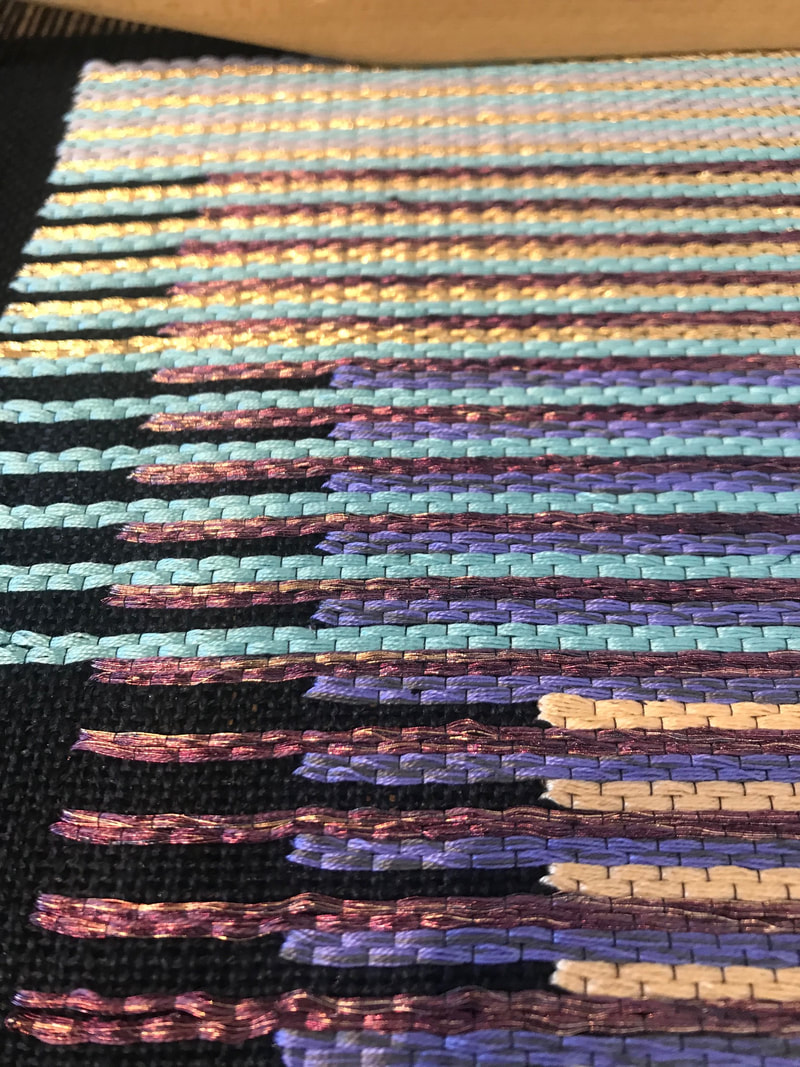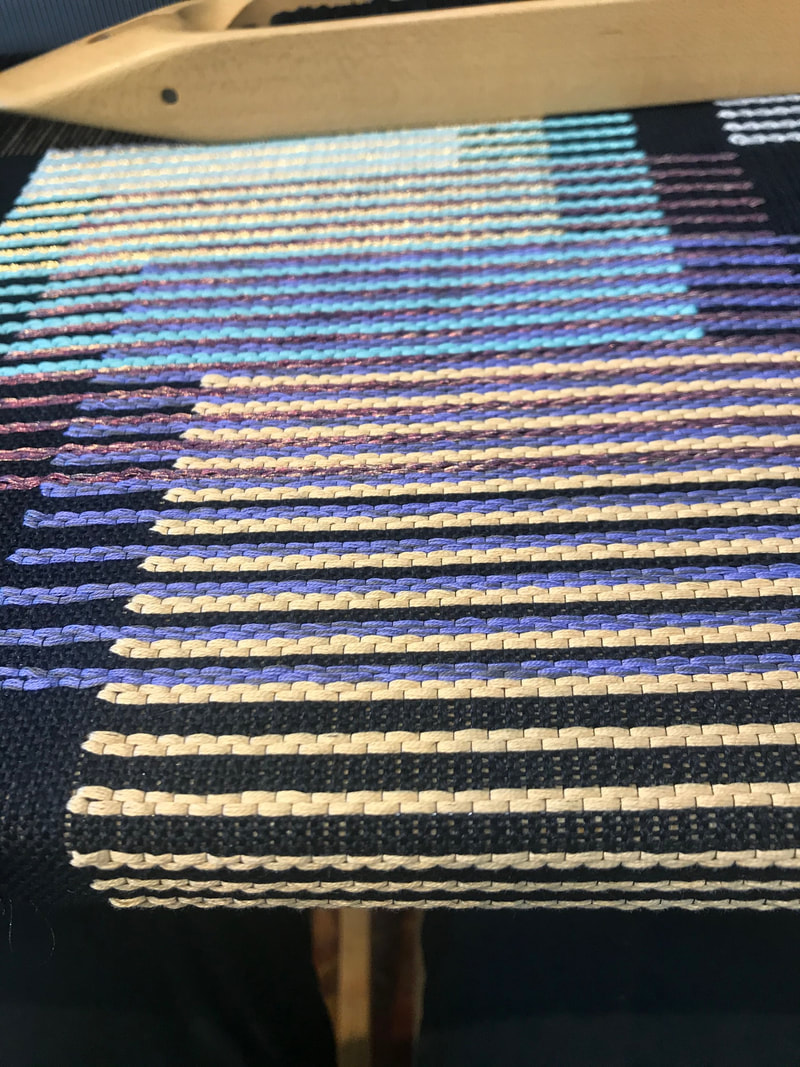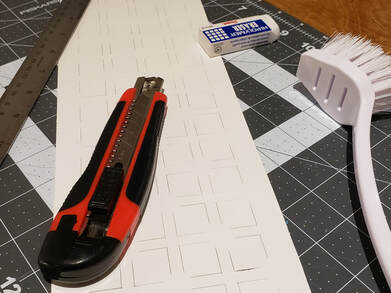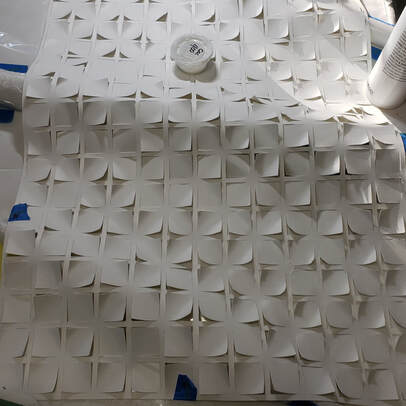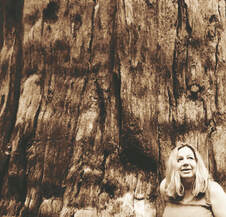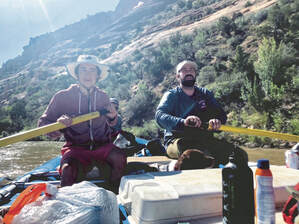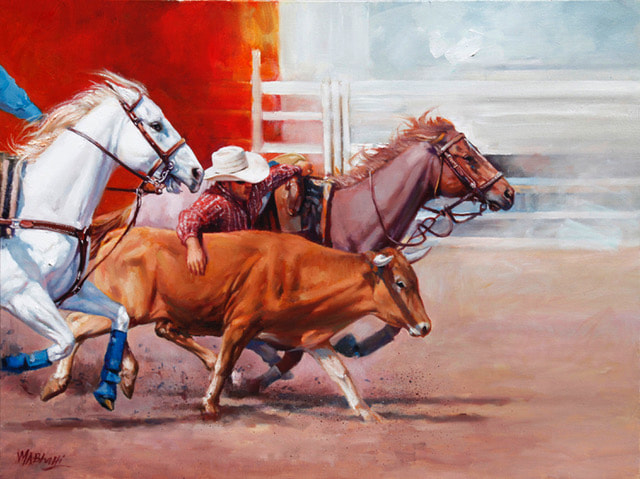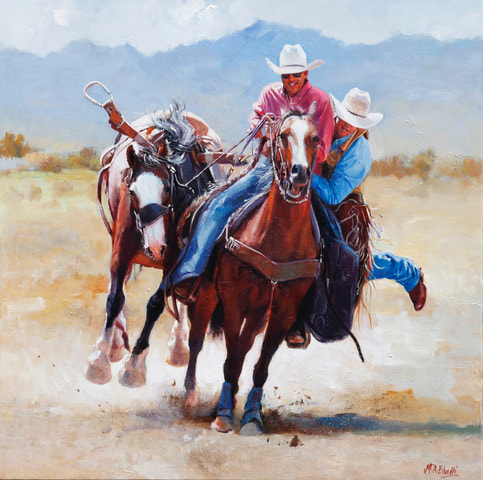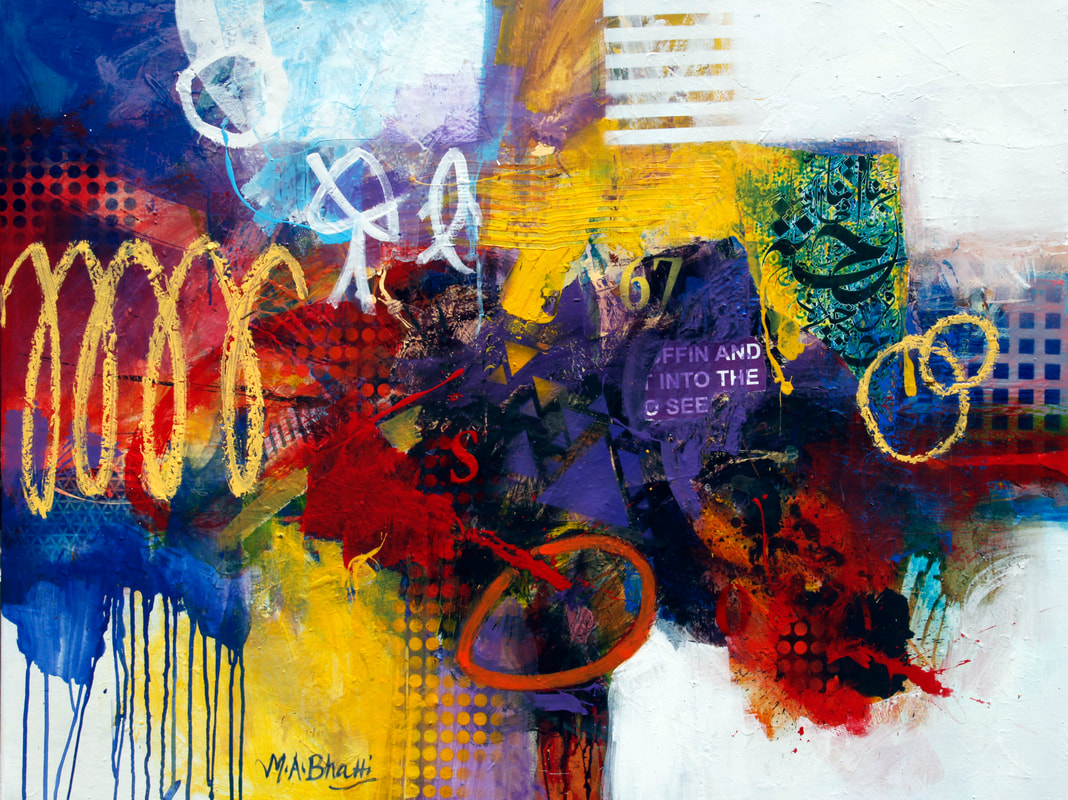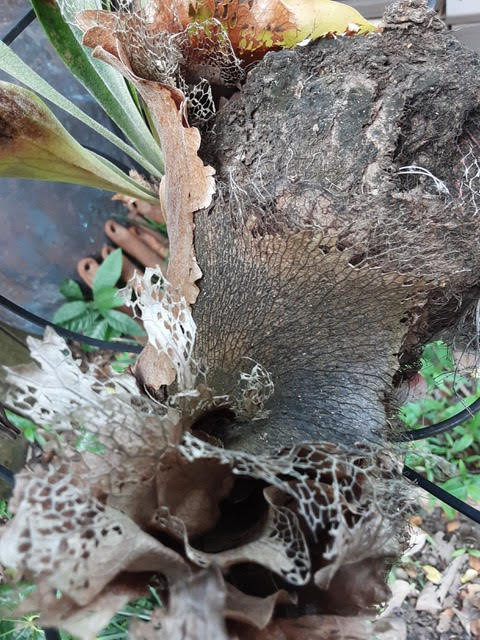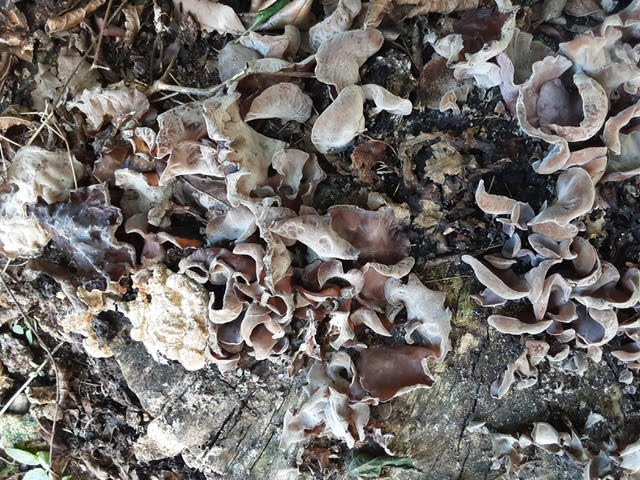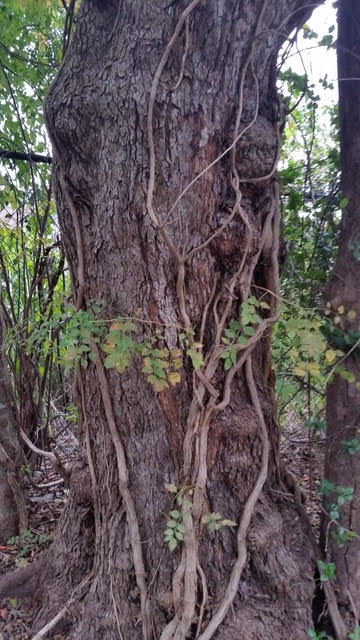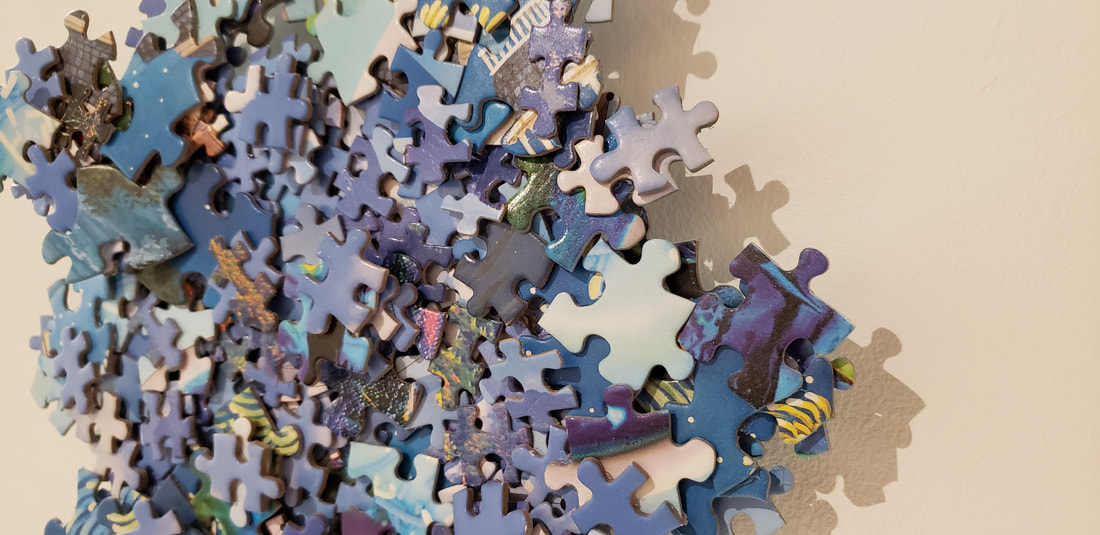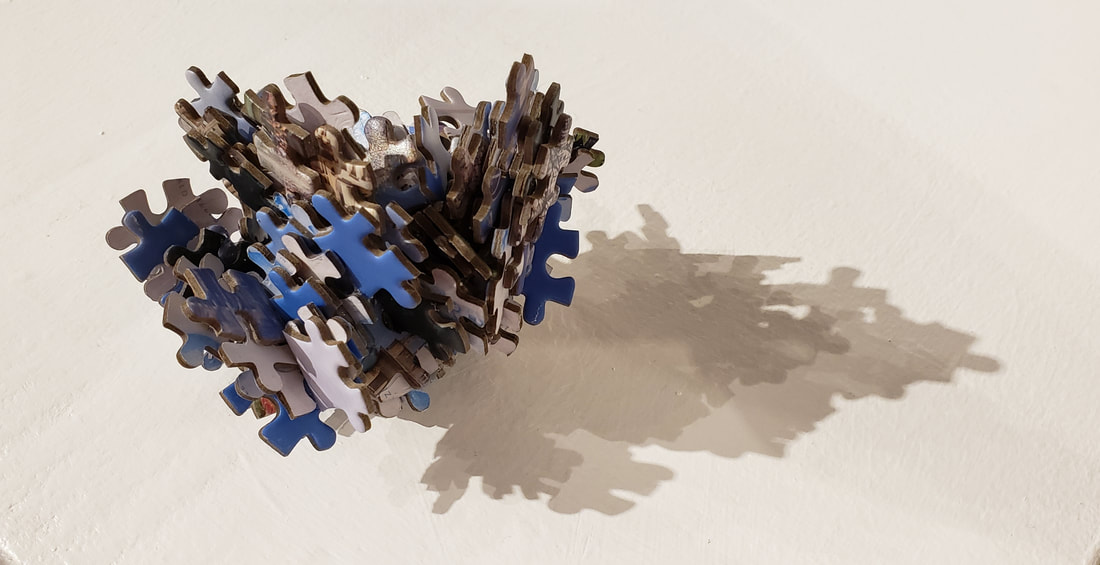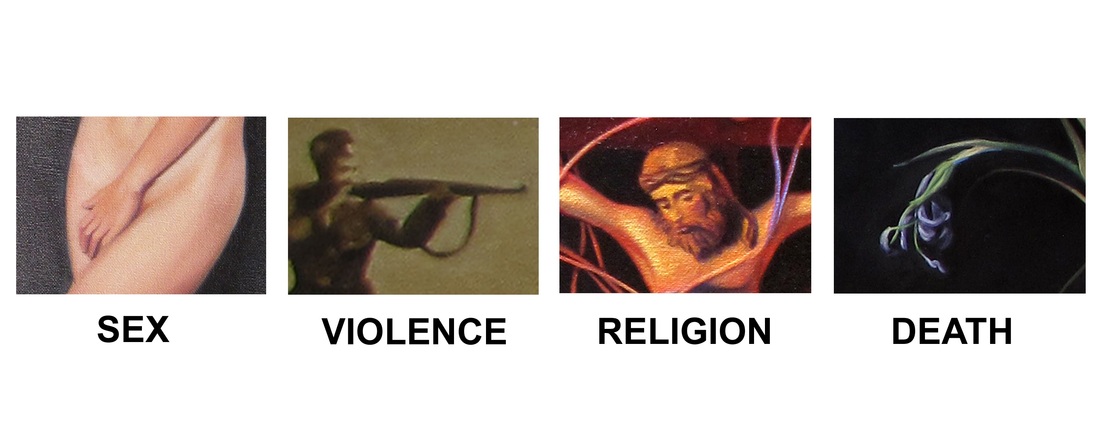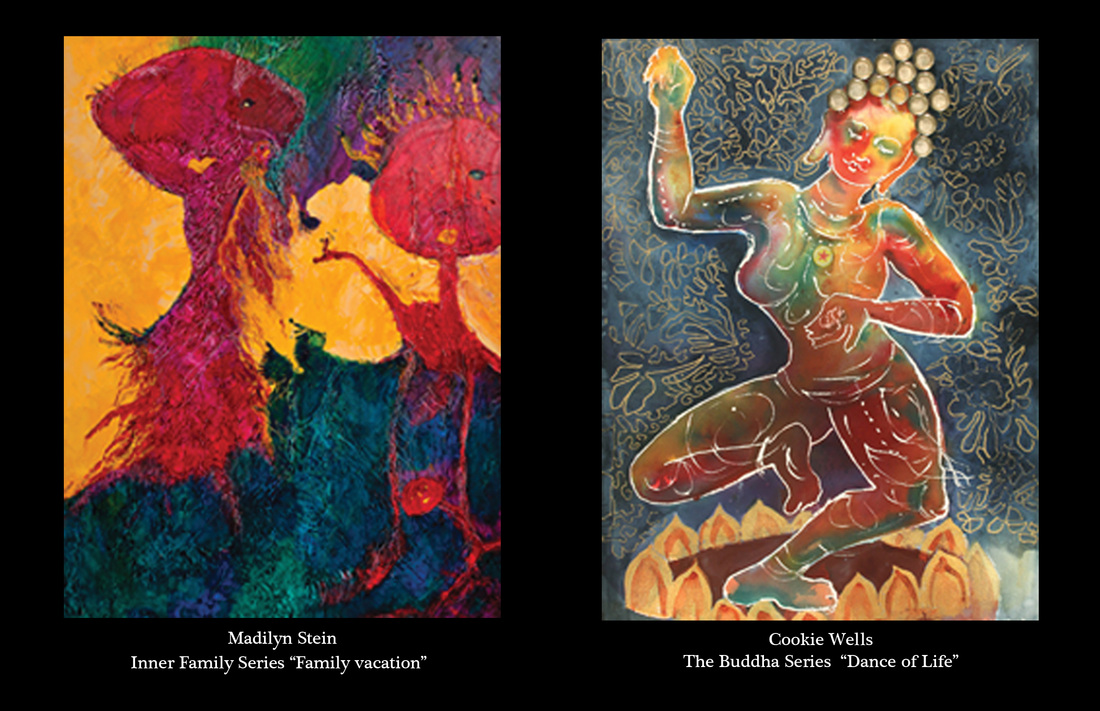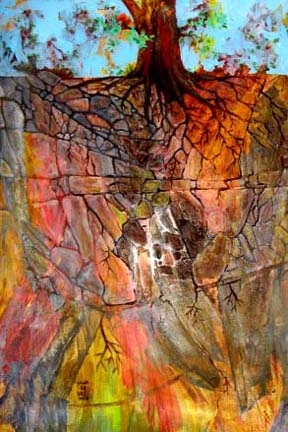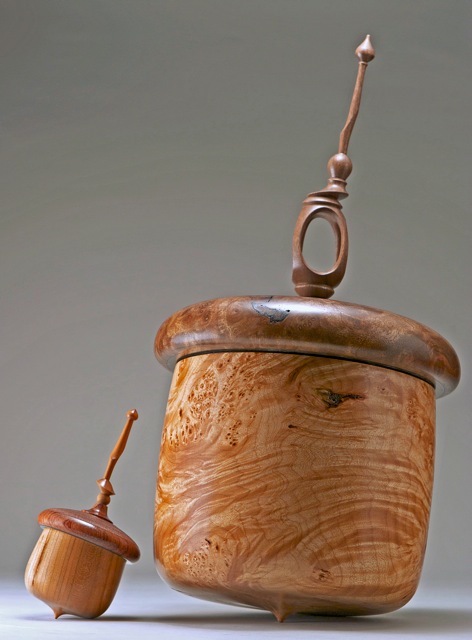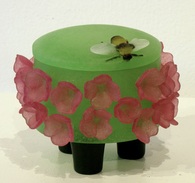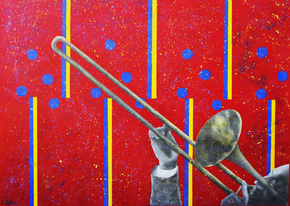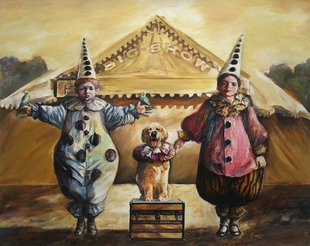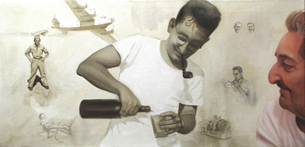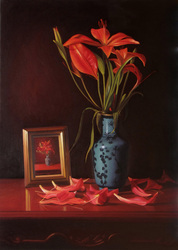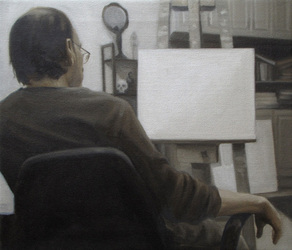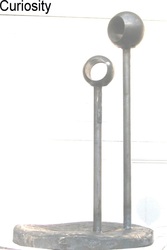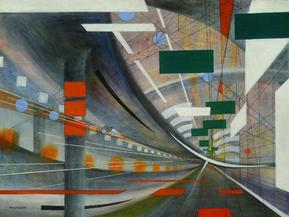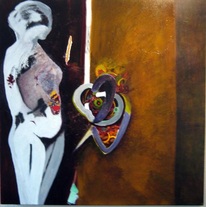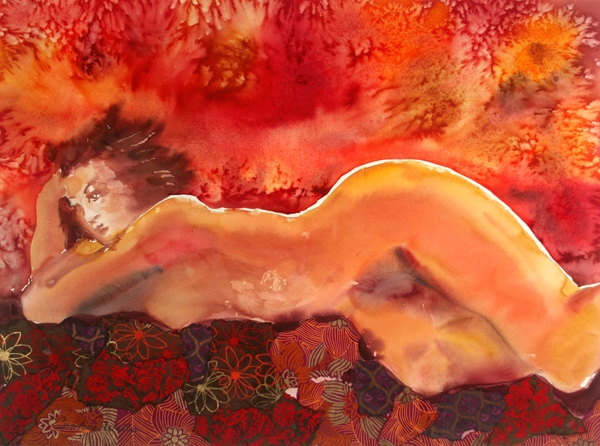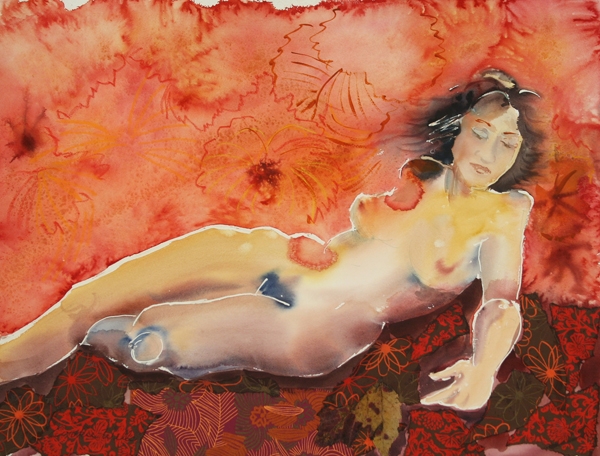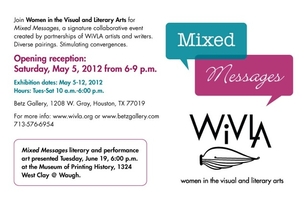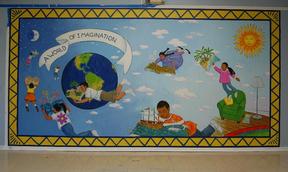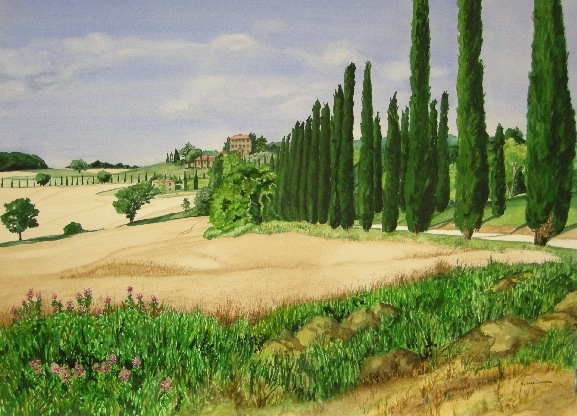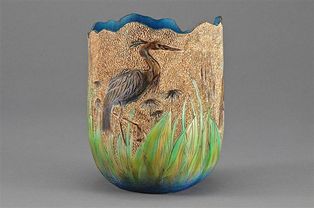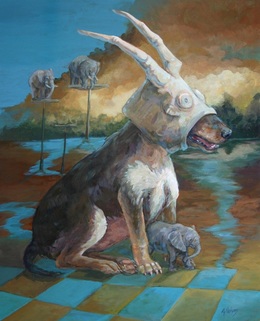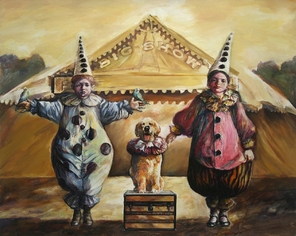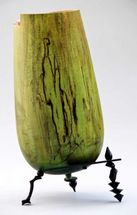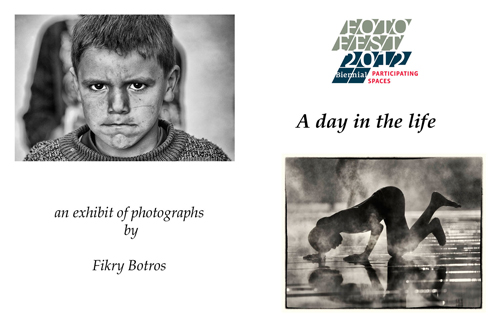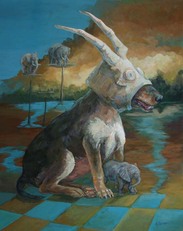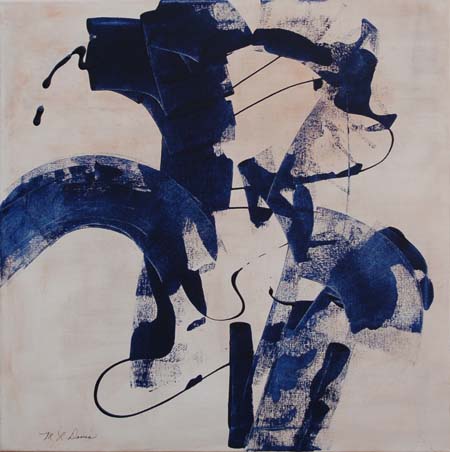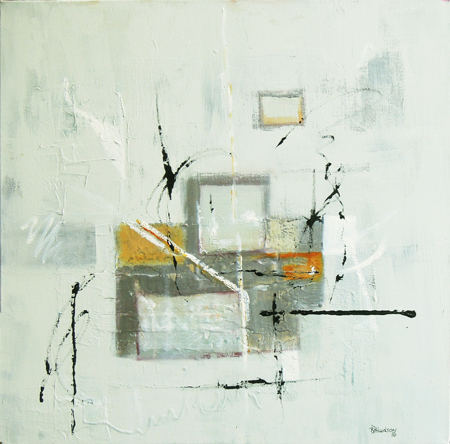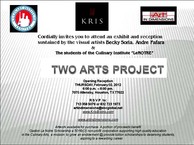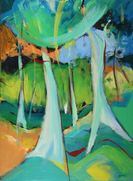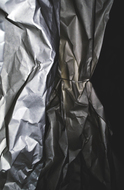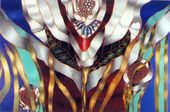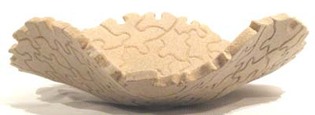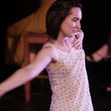|
Becky R. Soria I come from an art-oriented family where classical music and art surrounded me. My father was an internist doctor who dabbled in painting but mainly collected it; he also was a collector of ancient South American art. My brother, Fernando Casas, showed his talent for the arts at an early age; he is now a full-time artist and philosopher. I was interested in drawing and painting from an early age; in my teens, I was also interested in choreography and ballet dancing. During this time, I felt a growing interest in the pre-Columbian artifacts and minerals from my father’s collection and in learning about ancient cultures of the world. I do remember painting a couple of those large stones with oils for a ballet choreographed performance; of course, those stone faces were never the same and I got into big trouble for painting them! As I grew older, becoming more aware of the disparities and inequalities of females through history, I became sensitive to the plight of women. This sensitivity along with the combination of my interest in ancient Paleolithic cave paintings began an ART journey which would eventually help me evolve into who I am now as an artist. Most of my work depicts female figures, although not exclusively. The work is of human figures transformed abstractly showing wonder and pain; nature is woven into the figures along with hints of myths and past primitive cultures. These are works of intimate explorations, but they are also universal to all women. In my paintings, I approach the human figure less from its familiar shapes, and much more from within, making visible its visceral emotional life. Using abstractions of language, color, and texture that allow me to capture the profound sentiments that humans have felt throughout the ages for the Earth as Goddess and Mother, I explore the historical evolution of woman. Within the quietude of my studio, and while the pandemic ravaged the world, I let my sensations, feelings, visions, and thoughts of what we were experiencing further my investigation of the human body and its inner reality
This collection of images flows from the stark perceptions of the difficult times we are living in. They juxtapose the fragility and strength of the human spirit. These images are at once representations of personal and universal images engendered by my muse, the mysterious source of creation. The meditative journey that walked me through the real and illusory perceptions of the body and its ability to heal, brought to life this exhibition of twenty-five works. Modern women declare their ability to rise above and create passion on their own behalf; they embody memories of their consciousness and union with the natural instinctual life. Art is mysterious it urges me to BE. I nurture it – it nurtures me back. by Silvia PintoSouza I paint from the heart, and a gut feeling. I don’t follow scientific theories when it comes to color, composition, and shapes. I paint objects as my heart sees them and their potential to become works of art. My aim is to give ordinary elements of daily life a new identity. They can become “Stars,” no matter how humble their origins. I see Art all around me; anyone who has the eye of an artist, trained or not, would agree. The world is rich with Art, and our role as artists is to discover it.
I have been painting since early in life. My mother was an artist herself, and I used to draw next to her. She would just let me do what I pleased, and felt the results were not too disappointing; she thought that I had talent. Much later in art school, I learned the basics of many different techniques, especially in the artform of Printmaking, and after several years of experimentation, I decided that I needed something where development and results could be seen in a more immediate way. As a result, I have been painting for the last 30 years in acrylic. This medium gives me a wide range of possibilities by painting directly from the tube to diluting the paint in water to build up various values of color with multiple layers. I believe my paintings are intimate, romantic, and direct. My message is the image itself, and what it can bring to your heart. I hope that when you look at my work, you are caught in that beauty and are living it because Art is comfort. It is where we take “Shelter.” It is the shoulder where we can rest our head. Sitting on my porch swing on a glorious Houston afternoon, just days after the horrid storm that took lives, burst pipes, destroyed homes, gardens, bats and birds.
I’m marveling at leaves still clinging to oaks, shriveled on palms and citrus. My papaya tree is done for, despite all the wrapping and pre-emptive care. The container plants, moved to shelter, are all outdoors again, reaching into the sun. The backyard birds and squirrels have been out in force, though we haven’t yet seen the little cardinal couple. I hope they survived. Nature’s regenerative force can cruelly cull even the sweetest and most gentle of creatures. If they emerge or return, we will rejoice and feed them well. - Liz ConcesSpencer Carol: “Coming up with ideas and designs is so easy compared to figuring out how to execute them!” So true. The job of artists in creating new work that informs, inspires, delights and delivers is fraught with learning curves. To constantly challenge oneself is inherent in any creative field; artists rarely settle in to a comfortable middle ground. To do so would threaten that their work becomes mere production, mere doing. The learning curve of introducing new techniques, new ideas or new strategies is key. Gene: “I’m not sure how to do this. I’m going to figure out a way.” Liz: “It’s funny: even the pieces I thought would be simple in their execution are posing challenges. Mirrors the times we are living in, I suppose. That or I’m on a slow steady decline.” Artists: Carol Berger, Gene Hester, Liz Conces Spencer
by Jiashan Lang Growing up in an artistic family, my grandfather dedicated his life to bringing back the art form of dough figurines and other intangible aspects of our cultural heritage. Thus, I was inspired to preserve and promote Asian culture and arts myself.
To me, making dough figurines has always been a relaxing moment where I can create something beautiful and representative of my culture. But leaving my family and immigrating to the U.S. has taught me something more important; we can never stay in a “moment.” Everything in life, whether it makes us desire or despair will happen, and it will become something that happened in the past. My art has become a way that I can connect to the past and to my roots. It condenses all the feelings and emotions that I want to preserve in the moment and share with the world. When I read a book or hear a story, I see it through the form of dough figurines. I hope that the collectors of my art will carry home the same feeling that I have; the feeling of owning a sliver of time preserved in history. by Laura Viada I have been fascinated by color since I first saw Impressionist and Pointillist paintings at Houston’s Museum of Fine Arts on a high school field trip. The way the paintings looked so different up close and from a distance – how a field of small brush strokes or dots of different colors could transform themselves into recognizable forms and landscapes at a distance. It was another 20 years before I began my own artistic exploration of color. When I first began weaving, over 25 years ago, I experienced a lot of frustration over the fact that the colors I chose, when woven together, didn’t look as I expected them to. During that time, I happened to go to the MFAH again and encountered those same paintings. It was a “lightbulb moment” – I saw that the interaction of separate warp and weft colors in a weaving is the same basic thing as the cluster of dots and brush strokes in the paintings. My eyes are mixing the separate thread colors the same way they mix the dots and brush strokes in the paintings. Thus, began what has become a decades-long exploration involving the interaction of color and the way our eyes blend small areas of different color through a phenomenon known as “optical mixing.” I realized early on that I would have to go the root physical principles of how we see color to understand optical mixing and get the results I wanted in my work. When our eyes do the blending of two or more separate colors, the result is often quite different from the result obtained by mixing the same colors in paint. This is because the cones in our eyes employ a different set of “primary” colors from that used in pigment mixing. Optical blends in fiber also add a considerable richness and depth to a finished weaving. Throughout my creative journey, I have been inspired by the work of Josef and Anni Albers, leading Bauhaus figures and, later, teachers and artists in the United States. Josef Albers’s monumental text, The Interaction of Color, and his color studies using the simple square have provided a wealth of inspiration over the years. And, of course, the legendary weaver and artist, Anni Albers pioneered the concept of the woven textile as art, in its own right, independent of function. 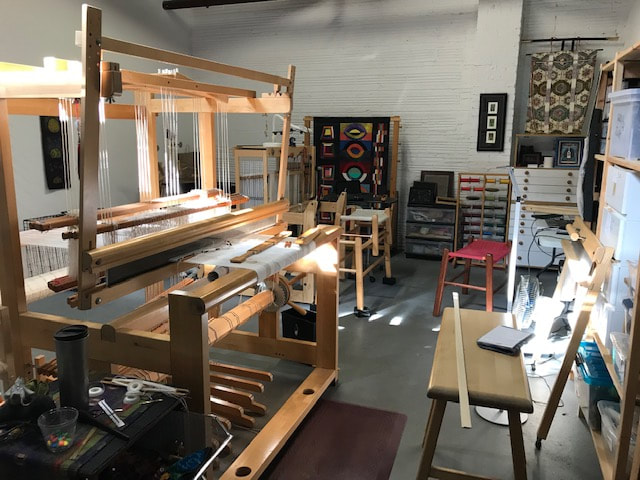 In 2011, I had the enormously inspirational pleasure of viewing the Carlos Cruz-Diez retrospective exhibition at MFAH. Cruz-Diez had an interesting method of exploring color that involved breaking a color plane and creating what he called “chromatic events” in areas where two or more broken planes come together. He often employed three-dimensional elements, light, and motion to create additional color and shape shifting effects. This was another “lightbulb moment” – I could use the concept of “chromatic events” to create depth and complexity in weaving. This set me on a whole new journey of exploration in the world of color and fiber.
What I’ve discovered over two decades of this exploration is that the possibilities are limitless. There’s always a new discovery to make, a new effect to be achieved. This journey will never be finished. I’m fairly good now at being able to plan and execute the color effects I want, but color has a magical quality at its core and a there’s a surprise waiting for me in each piece. That’s the great fun of it!! Tracey Meyer Making Art can be slow or quick. One series might not take long to figure out because the planning has all taken place cerebrally in the months before beginning. Other series are slow to come to fruition as the challenges have to be solved as one goes along. My series “What Shapes Us” was an intensive process, and slow to create, however the idea of it had been in my head for a long time. I had been cutting the apertures for months before I started doing the forming, which took a lot of perfecting to get ‘right’. As a person, I really value the handmade and strive to uphold this ideal in my life whether it be in the kitchen or the studio. Therefore, all of the apertures in the works were hand cut by me. Yes, that means thousands of cuts and bends to the apertures in the work. To me it is very satisfying to feel the medium in my hands and observe its abilities and qualities as one works with it. One learns a lot about the material and oneself as works intuitively within and sometimes outside the constraints of the material.
Gallery artist Barbara Able invited her son Daniel, to share her September Show, REINVENTION.
Barbara: “We chose the name of the show because we felt like there was a paradigm shift in our lives, due to the pandemic and quarantine. We felt that we had to reinvent ourselves and we wanted this collection of artwork to show that." Daniel: “I think the depictions in our show exemplify the changes that we’ve had to make. In some ways it is detrimental, and in some ways, reflective.” Barbara: “After the lockdown started, I wanted to use my paintings to give me a sense of comfort. I wanted to recollect times in the past which were meaningful to me – things that gave joy in life.” Daniel: “...I think that in the show, we exemplify how we reinvent ourselves; how we are resilient and are able to express ourselves creatively. For example, one of my pieces in the show is of an event I had participated in and where I had taken a photo right before the quarantine started; I think it is kind of an homage, and reminiscent of what I previously appreciated. What is reflected is a trip where I had a near death experience; I fell off a raft and got swept away in the Colorado River rapids. Now, when I look back, it really speaks to me as a momentous moment in my life and I think it shows that we can make it through anything." Barbara: “I’m so glad that I didn’t know about it until you got home!” A few years back, Barbara owned a gallery in Santa Fe, New Mexico. During that time, she worked Monday through Thursday in Houston at her Corporate Art job, then flew to Santa Fe on weekends. Barbara was also a volunteer art teacher in Daniel’s school from Kindergarten through 8th grade. Daniel: “It’s pretty crazy to think back to the time when my mom was working so hard at starting her own business. It is a testament to her drive and how determined she is to be successful; she wants to spread her creative expression throughout the world. By growing up with my mother so involved in art, I was exposed to all different types of art. Because of this, art has gotten me through a lot of tough times and I really appreciate it." Barbara: “Thank you! I am so excited to see you starting out on your own art calling.” Barbara Able and Daniel Able’s Artist Talk for their show, Reinvention, will be available Saturday, September 12 at 6:30 p.m. via Facebook Live or on the Archway Gallery website. The show will hang in the Front-Space of Archway Gallery and can be seen by appointment or during the gallery’s “Drop-In” hours. Check Archway’s website for details and updated gallery hours. Both artists welcome commissioned artwork opportunities. I was born and raised in Pakistan. In 2015, I retired from my position as Professor and Director of the Institute of Art and Design in Sindh, Pakistan, then migrated to the United States to be with my son and daughter who live in Houston. I became active in the Watercolor Art Society of Houston, the Portrait Society of America, and the Visual Arts Alliance. In June 2018, I joined Archway Gallery and this is my first solo show at the gallery. For this show, I have included my abstract paintings along with a few portraits and some Southwestern paintings to show the range of my painting styles. Living in Texas, I am greatly captivated with the beauty of the Southwestern lifestyle, ranches, and the rocky landscapes. For me, painting horses is a breathtaking experience. I like saddles, roping activities, rough barns, woods and the life around the campfire. My compositions are filled with the energy and exciting lives of the characters I portray. Liz Conces Spencer: The Show Goes On
Becky Soria and I are hopeful about the Juried Show this year. We have been growing this big healthy baby, now a preteen, with the help of the artists in the community for more than a few years now. With the pandemic and its effect on all of us, we have hit the boll weevil, the pothole, the tear in the fabric, the muddy patch, the _________(fill in your own metaphor). Artists, being the resilient weeds in the pavement that they are, continue to enter despite hiccups with the online entry system. Neither Bec nor I are especially fond of, or literate in, these technologies but we are soldiering on. To the rescue have come John Slaby, Joel Anderson, Harold Joiner, and Christie Coker, helping artists get their entries in and processed. We certainly miss the good old days of the past 9 – 10 years when we have had the juror select the show from actual works of art. Although we realize the front-loaded hassle for artists to bring works in to be judged, it is also the most authentic way to select a show; art needs to be experienced in person, when possible, in order for its impact to be felt. Minus that, with digital entries we can judge dimension, scale, texture, and other qualities solely by the quality of the images submitted. Cameras have come a long way, but there is no experience like the physical one, and we long for the good old days. I hope that artists will persevere and enter the show. Our juror this year, Wayne Gilbert, is a friend to artists. He is an artist himself, a man of soul and conscience. He will choose wisely and well. Our charity partner Houston Junior Forum has deep fingers kneading the bread of the community. It funds many small organizations and is kept afloat through donations and a guild shop, paying forward friendship and opportunity. Bec and I, and the other Archway artists, will miss the big public reception that awards prizes and recognizes the selected works but the gallery will honor them at 6:30 p.m. on July 5 when our announcement video drops and reveals the show and winners; I hope you will all tune in. The show will be hung physically in the front gallery, to be viewed by appointment and during the gallery’s new open hours on weekends. As you may know, 50% of the sales benefit the selected artists, and 50% goes to the charity partner. All selected works will be featured on the gallery website and we will make every effort to connect them to new homes. I thank everyone for their support of this event. Liz Conces Spencer Hello Archway Fans!
My show has been up close to a month and I hope you have time to look at it online, at the gallery by appointment, or at the gallery on weekends during our new limited hours. I hate to blow my own horn, but I got to admit this is some of my best work to date. I think there are some special pieces in this show and if you have had time to check it out, I hope you think so too. A few pieces have already sold and, hopefully, there will be a few a more. I was incredibly pleased when the artwork installed as it looked even better with the gallery spotlights shining on each piece. I was worried that the show might look disconnected and somewhat disjointed because I do so many different processes but Harold Joiner, one of our resident gallery curators, pulled it all together. It turned into a show that I could only hope for after all the years of artmaking. My art does not tell stories, make political points, or any other kind of statements. What I want is for you to enjoy the colors and movement of each piece. I want you to be uplifted and happy when you look at my art, and I want you to never tire of looking at pieces once hanging on your wall. The show is mostly glass and steel but there are a few stand-alone wood pieces. I especially enjoy the wood pieces because it reminds me of my many years of making foundry patterns; I am pleased that I still have the skills I acquired some 50 years ago and still have the thought process to do the job. Turning a doodle in my sketchbook into a 3-D piece of art is something I have always enjoyed. Doing the engineering and the machine work, as well as the finishing, is always a fun challenge! Sometimes it is a pleasure and other times it is just a great disappointment which goes on the shelf under the table for another day. My mind is never at rest! I am constantly thinking about new projects regardless of whatever else I may be doing. I am a maker and always have been. My whole life I planned to have a place where I could work and have the equipment to make any project imaginable. After much work, my studio is just that kind of place. I attend workshops and am constantly learning a new process. In my opinion, to be great in art you must keep learning and growing daily. You must challenge your skills on every project you create so every new piece is different and better than the last piece. I am always looking forward to my next creation and, hopefully, my collectors feel the same way by continuing to collect and enjoy the fruits of my artistic labors. Creating is a way of life; I plan to be creating until the very end. There is Another Garden combines two of my life-long loves: art and gardening; art came first and, seemingly, naturally. Trained as an architect, I saw garden design as an essential part of fashioning a holistic environment - the inside and the outside, the built and the natural, the planned and the organically evolved. It wasn’t until I reached my adult years that I found myself really wanting to garden. The art side of it inspires me; the science side of it challenges me. In the beginning I found it is easy, but only if I could get the plants to do exactly what I want them to do! Deciding that Dollar Pennyroyals are a good-looking ground cover was a comforting acceptance. Ah, but the challenge was part of the fun. After I decided that it was all going to be just one big experiment anyway, everything was good. Seeing butterfly caterpillars decimating milkweeds, discovering chrysalises in the most unlikely places, releasing ladybugs, sighting a green anole puffing up his red throat, finding a broken blue egg shell of a robin on the ground, studying the curlicues of mushrooms sprouting from a cut tree stump, and observing the very fine veins of a staghorn fern shield (Staghorn Fern Series), are just a few of myriad delights and yes, also pain, that my garden offers me. In one corner of my yard, under a second-floor deck,there is a rain garden. Enclosed by a wall on one side and fences on two sides, bordered by a compost area with a cairn (where a beloved cat is buried) to one side of it, a pile of twigs provides refuge to small critters. An Eastern Redbud next to this garden has had conks (polypores) growing on the trunk so I know it is in distress and it is slowly showing its decline. Hanging Ball Mosses from the structure of the deck above drape down and gives an air of a mysterious garden. It inspired me to create Rain Garden Rhapsody series. I find solace in the stately tree trunks. Musing on them gave me the idea to create the Tree Bark series, using pages from books as a tie between the idea of trees and the passage of time, the making of books with the exchange of ideas, and so on.
My garden is a living canvas for me and a place where I can go to refill my creative well. It is rather lovely to note that there has been an increase in people doing jigsaw puzzles during the time of the Covid-19 pandemic. Obviously puzzles have not lost their power to entertain people either singly or in groups. Even the ‘rich and famous’ are secret puzzlers. Amie Tsang in her New York Times article said, “Patrick Stewart once called the world of jigsaw puzzles a “secret society.” She even mentioned that the Australian Prime Minister has announced that jigsaw puzzles are an ‘essential item’ during ‘lockdown’ and that people are allowed to leave their homes in order to procure them. Images of puzzle pieces being laid out methodically across nations, possibly first the edge pieces and then working with groups of colors or patterns come to mind. There are strategies to consider! Why are people drawn to jigsaws? There is something soothing about taking a box of jumbled pieces and making order out of them, thereby creating a wonderful image. Why do I work with jigsaw pieces? I think it is something about the jigsaw pieces themselves. The shapes are so interesting and familiar and fit so nicely in the hand. I work with puzzle pieces because their shapes remind me of people. With these miniature people, I tell stories about human foibles and how humans interact with one another. My work is not so much about creating order as I make sculptures. As I place one puzzle piece against another I am reflecting on the human condition and how our attitudes to one another today are pivotal to society’s success.
Archway Gallery had a fantastic and successful 2013, thanks to all our friends and patrons. 2014 greets us with an exciting show in our front gallery, featuring works from Harold Joiner and Judy Elias: Fifty Shades of Green.
Fifty Shades of Green is a perfect art exhibition to be held during the winter months. Imagine sunshine and warmth. Nothing enriches a viewer more than the radiance of sunlight in beautifully painted canvases. And Providence has brought together Judy Elias and Harold Joiner to make it happen. Both paint outdoor environments, and this show chronicles their achievements. Judy Elias is a plein air painter who travels the world to find the subjects of her inspiration. Because she works on site, her paintings are usually completed in one sitting. The canvases are small and precious. They facilitate armchair travelers, and beckon the viewer to come close to appreciate them. The paintings are framed in gold, and are hung as if they are in a fine old home. Harold Joiner finds much of his subject matter in the nature preserves and state parks of south and central Texas. The flora and fauna of a locale are his focal point, and he is drawn to include bodies of water within his imagery. He uses sketches and photographs record the scene, but the paintings are created in his studio. The end result are exquisite landscapes that capture the beauty of Mother Nature. Joiner's iconography is refreshing. His treatment of the interplay of vegetation against the water's surface are visual delights. Inappropriate for Public Space |
Hours | Phone
Tue-Sat 10-6, Sun 1-5
713.522.2409 |
Location
2305 Dunlavy
Houston, TX 77006 |
|

